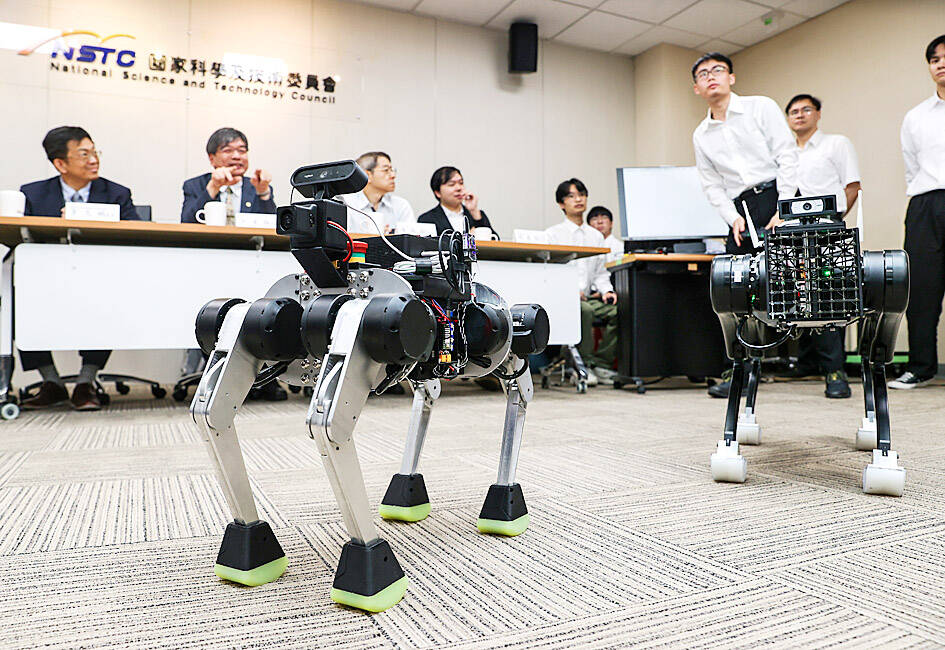National Taiwan University (NTU) yesterday unveiled Taiwan’s first artificial intelligence (AI) robot dogs, which can work in industrial settings to alleviate labor shortages and assist during rescue operations.
The team who worked on the “NTU DogBot” project, led by mechanical engineering professor Kuo Chung-hsien (郭重顯), demonstrated the two models, dubbed Oliver and Dustin, at the National Science and Technology Council’s headquarters in Taipei, as the council helped fund the project.
Kuo and council officials said the project is just the start of Taiwan’s AI robot dog industry, which would be competitive in the global market, as the robots’ projected production cost of US$50,000 is about 50 percent less than what companies from other countries have quoted.

Photo: CNA
Oliver, the “pet robot dog” version, weighs 16kg and is 54cm long, while Dustin, the “field operations robot dog,” weighs 40kg and is about twice the size, Kuo said.
As both are equipped with sensors, can navigate autonomously and are capable of AI learning, the team expects them to be able to climb stairs and move over complex terrain by the end of this year, he said.
The team developed the robots by integrating new technologies while working with domestic companies to gain an understanding of their potential applications in different industrial sectors, Kuo said.
They could help to alleviate Taiwan’s labor shortage, especially in the petrochemical, construction, railway, food delivery and service sectors, he said.
The four-legged robots can navigate complex terrain, and could also be used for rescue operations, Kuo said, adding that robot dogs have been used to film the inside of burning buildings before firefighters go in.
Dustin is suitable for industrial applications and food deliveries, as the robot has sensors that can pick up sound, temperature, gas and other readings, while Oliver has slightly different functions, as it can respond to voice controls and facial expressions, and is more suitable for the home environment, he said.
The NTU team began Taiwan’s AI robot dog project two years ago, in cooperation with the council, after finding that similar robots produced overseas were quite expensive and had problems integrating with Taiwan’s digital network and AI systems, Kuo said.

The combined effect of the monsoon, the outer rim of Typhoon Fengshen and a low-pressure system is expected to bring significant rainfall this week to various parts of the nation, the Central Weather Administration (CWA) said. The heaviest rain is expected to occur today and tomorrow, with torrential rain expected in Keelung’s north coast, Yilan and the mountainous regions of Taipei and New Taipei City, the CWA said. Rivers could rise rapidly, and residents should stay away from riverbanks and avoid going to the mountains or engaging in water activities, it said. Scattered showers are expected today in central and

COOPERATION: Taiwan is aligning closely with US strategic objectives on various matters, including China’s rare earths restrictions, the Ministry of Foreign Affairs said Taiwan could deal with China’s tightened export controls on rare earth metals by turning to “urban mining,” a researcher said yesterday. Rare earth metals, which are used in semiconductors and other electronic components, could be recovered from industrial or electronic waste to reduce reliance on imports, National Cheng Kung University Department of Resources Engineering professor Lee Cheng-han (李政翰) said. Despite their name, rare earth elements are not actually rare — their abundance in the Earth’s crust is relatively high, but they are dispersed, making extraction and refining energy-intensive and environmentally damaging, he said, adding that many countries have opted to

People can preregister to receive their NT$10,000 (US$325) cash distributed from the central government on Nov. 5 after President William Lai (賴清德) yesterday signed the Special Budget for Strengthening Economic, Social and National Security Resilience, the Executive Yuan told a news conference last night. The special budget, passed by the Legislative Yuan on Friday last week with a cash handout budget of NT$236 billion, was officially submitted to the Executive Yuan and the Presidential Office yesterday afternoon. People can register through the official Web site at https://10000.gov.tw to have the funds deposited into their bank accounts, withdraw the funds at automated teller

CONCESSION: A Shin Kong official said that the firm was ‘willing to contribute’ to the nation, as the move would enable Nvidia Crop to build its headquarters in Taiwan Shin Kong Life Insurance Co (新光人壽) yesterday said it would relinquish land-use rights, or known as surface rights, for two plots in Taipei’s Beitou District (北投), paving the way for Nvidia Corp to expand its office footprint in Taiwan. The insurer said it made the decision “in the interest of the nation’s greater good” and would not seek compensation from taxpayers for potential future losses, calling the move a gesture to resolve a months-long impasse among the insurer, the Taipei City Government and the US chip giant. “The decision was made on the condition that the Taipei City Government reimburses the related